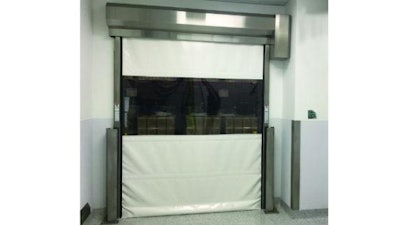
The combination of technological advancements, increased regulation and efficiency initiatives have transformed many industries – especially those in pharmaceutical operations. A prime example of this can be seen in the design and composition of doors for cleanroom applications.
Product integrity and contamination control are ever-present concerns in any pharmaceutical processing facility, and cleanrooms and wash-down protocols play a key role in ensuring both. Removing contaminants from production processes is imperative to meet standards and provide the highest quality products.
Although no two cleanrooms are exactly the same, they are designed with the same goal in mind – to minimize contamination, whether it is the level of dust, microbes, aerosol particles, chemical vapors or other airborne contaminants in specific process areas. Cleanrooms use high-efficiency particulate air (HEPA) filters to remove particles larger than 0.5 μm (0.02 mils). The goal in virtually all of them is to maintain an air pressure differential between rooms, pushing air from the opening’s cleaner side to the less-clean side. Occasionally, the goal is to keep particulates within a certain room to avoid cross-contamination with the processes in adjoining rooms. For these reasons, most facilities incorporate multiple pressure steps within the building’s structure. The steps typically range from 5 to 13 Pa (0.02 to 0.05 w.g.) between rooms, but can be has as high as 50 Pa (0.2 w.g.).
Every cleanroom has a controlled level of contamination determined by the number of particles per cubic meter at a specified particle size. Requirements differ by application and defined by ISO classes; pharma industry cleanrooms are generally in the range of ISO 5, 6, 7 or 8. To give perspective, the outside air in a typical city contains 35 million particles per cubic meter in the range of 0.5 μm (0.02 mils) and larger in diameter, corresponding to an ISO 9 cleanroom. On the opposite end of the spectrum, an ISO 1 cleanroom allows no particles in that size range and only 12 particles per cubic meter of 0.3 μm (0.01 mils) and smaller.
Role of High-Speed Doors
High-speed doors play an essential role in maintaining clean operations in pharmaceutical plants. They are designed to address facility needs for environmental control, productivity and safety (as well as cleanliness). In cleanroom applications, they are used not only to prevent cross-contamination, but also to help maintain correct room pressures, air circulation rates and optimal operating efficiency.
Doors compliant with Current Good Manufacturing Practices (cGMP) and the U.S. Food and Drug Administration (FDA) are essential. Key considerations for any door configuration are ease of cleaning and durability. In all cases, these doors must be able to stand up to repeated cleaning with chemical solvents and have a smooth, hard, non-porous surface resistant to microbial and fungal growth. Doors should also have a tapered surface and edges that essentially eliminate harborage of dust or other contaminants and possess no sharp angles to minimize harborage of microbes. Additionally, they should:
- be corrosion-resistant (which is often a problem with older door systems);
- use stainless steel side frames and shrouds; and
- incorporate a lubrication-free design, since lubricants can attract particulates.
It is also advisable to avoid doors with exposed fasteners and coils, as they will take longer to clean and could harbor contaminants.
Air Locks & Other Considerations
The ability of cleanroom doors to accommodate site-specific needs is another consideration for industrial designers. These could include features such as vision panels, push plates, or other activation devices, as well as magnetic locks and – perhaps most importantly – interlocking systems (air locks). Air locks are found in entrances and exits, gowning and de-gowning areas, and material transfer locations. In all these areas, it is important to keep two doors from being open simultaneously, thus preventing air infiltration from one space to the other.
The best door systems allow for wireless interlocking of air locks. Breakaway capability is another recent advancement in cleanroom doors, allowing employees to push through the curtain in the event of a power failure. While this feature is not needed on a daily or even monthly basis, it will be greatly appreciated on the rare occasion it is required. Finally, low-voltage remote controls should be specified if possible as they provide a cleaner look and are easier to install.
A door capable of at least 50 Pa in pressure differential is needed to maintain a tight seal and minimize air leakage. Given the requirement to maintain pressure differentials, doors that seal tightly and cycle quickly are essential pharmaceutical processing. A properly designed door helps ensure the facility’s makeup fans can satisfy the required amount of makeup air needed to maintain pressure. Another prerequisite in overall door design is cleanliness, since doors must operate in a pristine production environment. Any high-speed door used in pharma operations must also balance the need for productivity with operational safety.
The New Generation
Traditionally, pharmaceutical facilities use bi-parting doors made from stainless steel or fiberglass. However, many facilities are moving toward upward-acting “roll-up” doors due to limited wall space. A rigid-panel center-opening door spanning a 6-foot-wide opening, for example, requires approximately 3 feet of wall space on each side when its panels open. A roll-up door, on the other hand, requires none, since its fabric “curtain” collects in a head assembly at the top of the door when it is opened.
A new generation of roll-up doors – featuring anti-microbial materials and other cleanroom upgrades – has come on the market in recent years. These new features, coupled with their tight sealing and high cycle speeds, are reasons they are catching on with pharmaceutical facility managers. State-of-the-art high-speed door models can move at up to 100-inches per second, minimizing air intrusion while increasing productivity
Conclusion
To ensure product integrity, pharmaceutical facilities require the most sanitary operations and equipment possible. The newest high-speed, roll-up doors are helping change the way the industry defines “best practices” when it comes to cleanroom and wash-down areas.
Jon Schumacher is the director of marketing for Rite-Hite Doors. He has been with the company for 20 years and is a former vice-chair of the Door and Access Systems Manufacturers Association (DASMA). Schumacher can be reached via email at [email protected].























